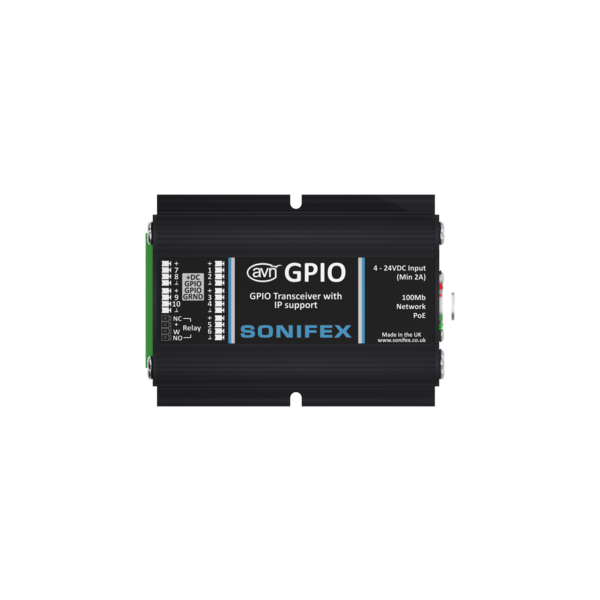Sonifex AVN-GPIO GPIO to LAN Transceiver (PTP, EMBER+ & UDP)
- ECO friendly webshop
- Personal advice
- 30 years of experience
- Over 4.000 products
- Secure payment
- Register and discover your discount levels
Specifications
Information
The AVN-GPIO is part of the AVN range of network interface boxes, which converts GPIO (General Purpose Inputs & Outputs) to network commands to control, and be controlled by, other equipment or software across a standard network.
It has 10 configurable GPIO's, 8 of which can be used for PTP based programming, together with a relay. It provides virtual GPIO that allow the device to trigger or be triggered by other Sonifex devices on the network using virtual GPIO without the need for extra wiring (virtual GPIO communication occurs via the ethernet connection). Units can either be interfaced together across a network, or you can use Ember+ and UDP commands to accept commands from, or drive, the AVN-GPIO.
The AVN-GPIO is a PTP (Precision Time Protocol) enabled GPIO device. IEEE1588-2008 PTPv2 is used to keep a hardware clock in sync with a PTP master, such as the AVN-GMCS Grandmaster Clock, to achieve a sub 10ns synchronisation to the master reference. This means that the AVN-GPIO can be used to accurately timestamp input events and to trigger outputs at configured times.
The AVN-GPIO supports Default and AES67 Media profiles, and also provides a Custom profile which can be configured by the user.
It is housed in a rugged aluminium box with side slots for screw-mounting and is powered by PoE (Power over Ethernet).
The device is configured via a built-in webserver. This allows the configuration of PTP as well as live monitoring of its status. A GPIO routing webpage is provided which allows physical, timed, and virtual inputs to be routed to physical, timed, and virtual outputs.
The AVN-GPIO provides a simple UDP messaging system that allows other devices on the network to query the device status information, for example to retrieve the time at which a change in input occurred. Custom applications can also be written to query this information via UDP.
The device has 8 "timed" GPIOs - when used as inputs these can detect the rising and falling edges and will generate a timestamp synced to the hardware PTP clock. This means that the recorded timestamps will be synced within 10ns of the PTP master in a correctly setup system. When setup as outputs, a signal can be generated precisely at a time chosen by you and the time at which the output toggles can be configured down to the nanosecond. Alternatively, these timed GPIOs can be configured to act as "normal" GPIOs depending on your application.
There are also two "normal" GPIOs. When normal GPIOs are configured as inputs they can be set to either momentary or latching mode. When setup as outputs, they pull the signal on the GPO pin down to ground when active.
The AVN-GPIO has a voltage free relay contact that can be used to operate external equipment, and also provides 6 x DC output voltage pins that can be used to power external equipment such as signage and various sensors and actuators. When powered via PoE (Power over Ethernet) the AVN-GPIO outputs 12V at 500mA total on these pins. When powered via the DC input the AVN-GPIO provides 12V at 1.5A total on these pins. The DC outputs are fused to prevent drawing more current than the device can provide and these fuses are automatically reset when the device is power cycled.
- 10 assignable GPIOs, 8 of which are PTP enabled.
- PTPv2 keeps the hardware clock in sync with a PTP master to achieve a sub 10ns accuracy.
- Single voltage free relay contact to operate external equipment.
- Virtual GPIO for sending physical GPIO action commands across a network.
- A single cable can be used for both power and control.
- The built-in webserver makes the AVN-GPIO easy to configure and allows it to be controlled by any device with a web browser.
- It can provide power to other devices via DC outputs.
- Uses Ember+ and UDP for communication, allowing programs to be written to interface with it.
- A PTP synced hardware clock ensures that when recording input events, even from two AVN-GPIOs a large distance away from each other, the timings are highly accurate (<10ns) with respect to one-another.
- It allows highly accurate activation of outputs - two outputs kilometres away from each other could be triggered with only a few nanoseconds difference when PTP synced.







